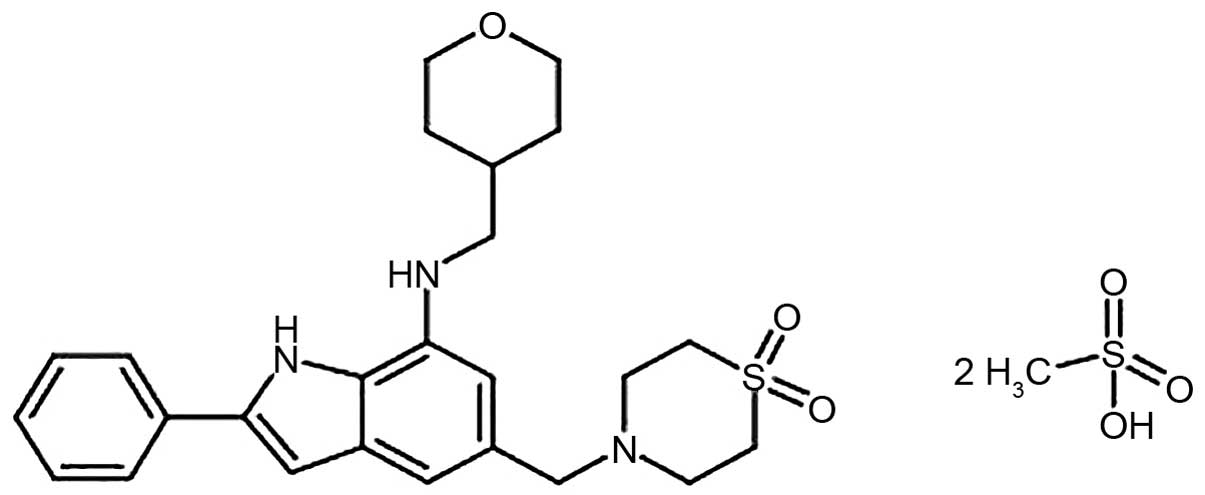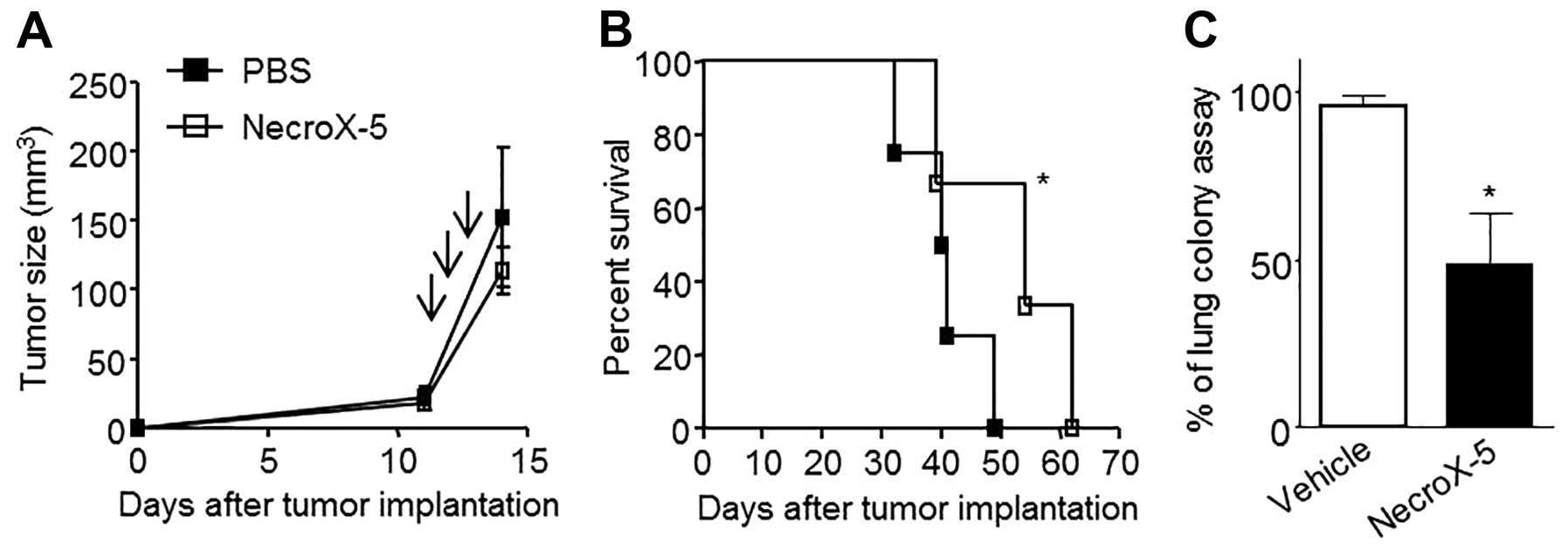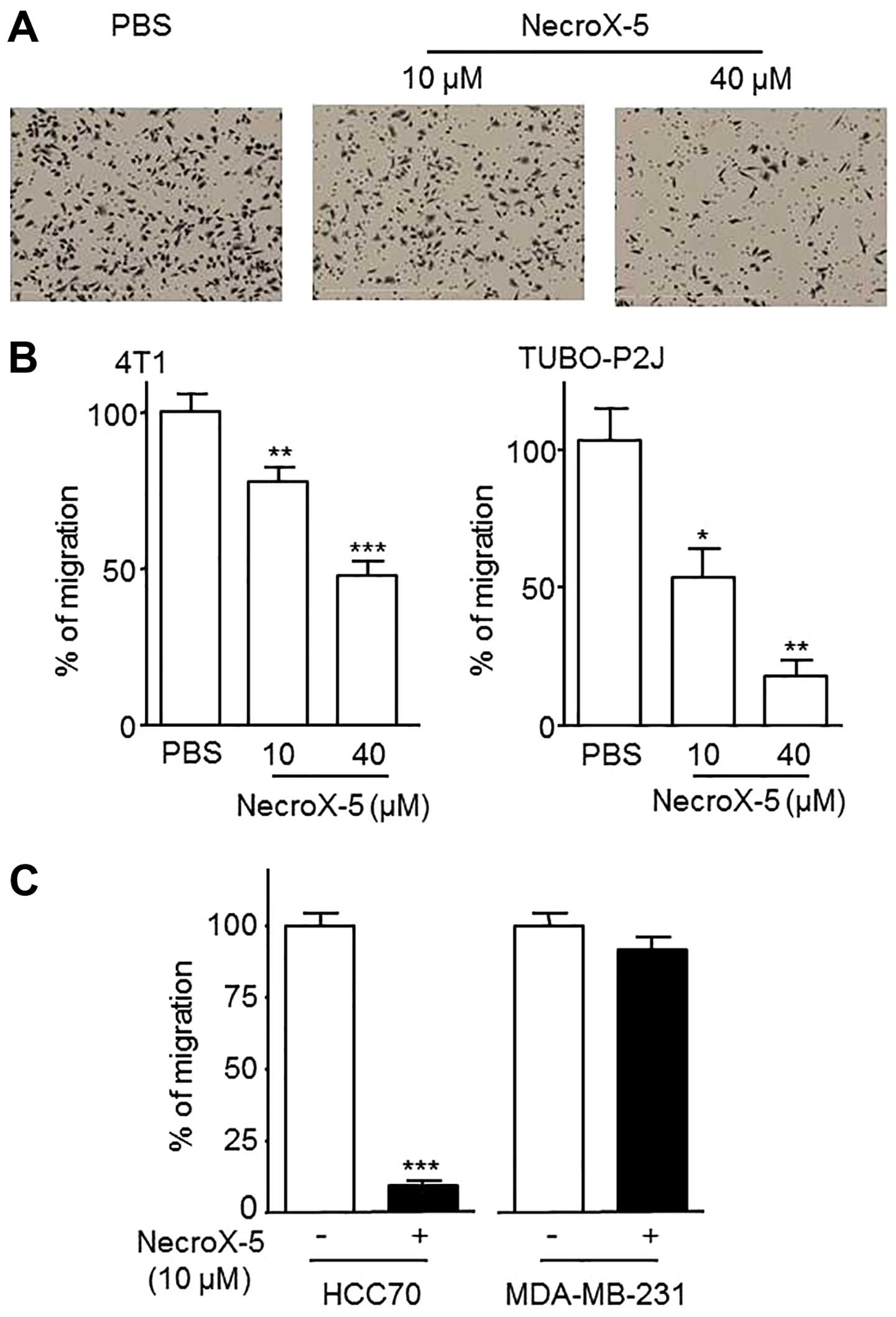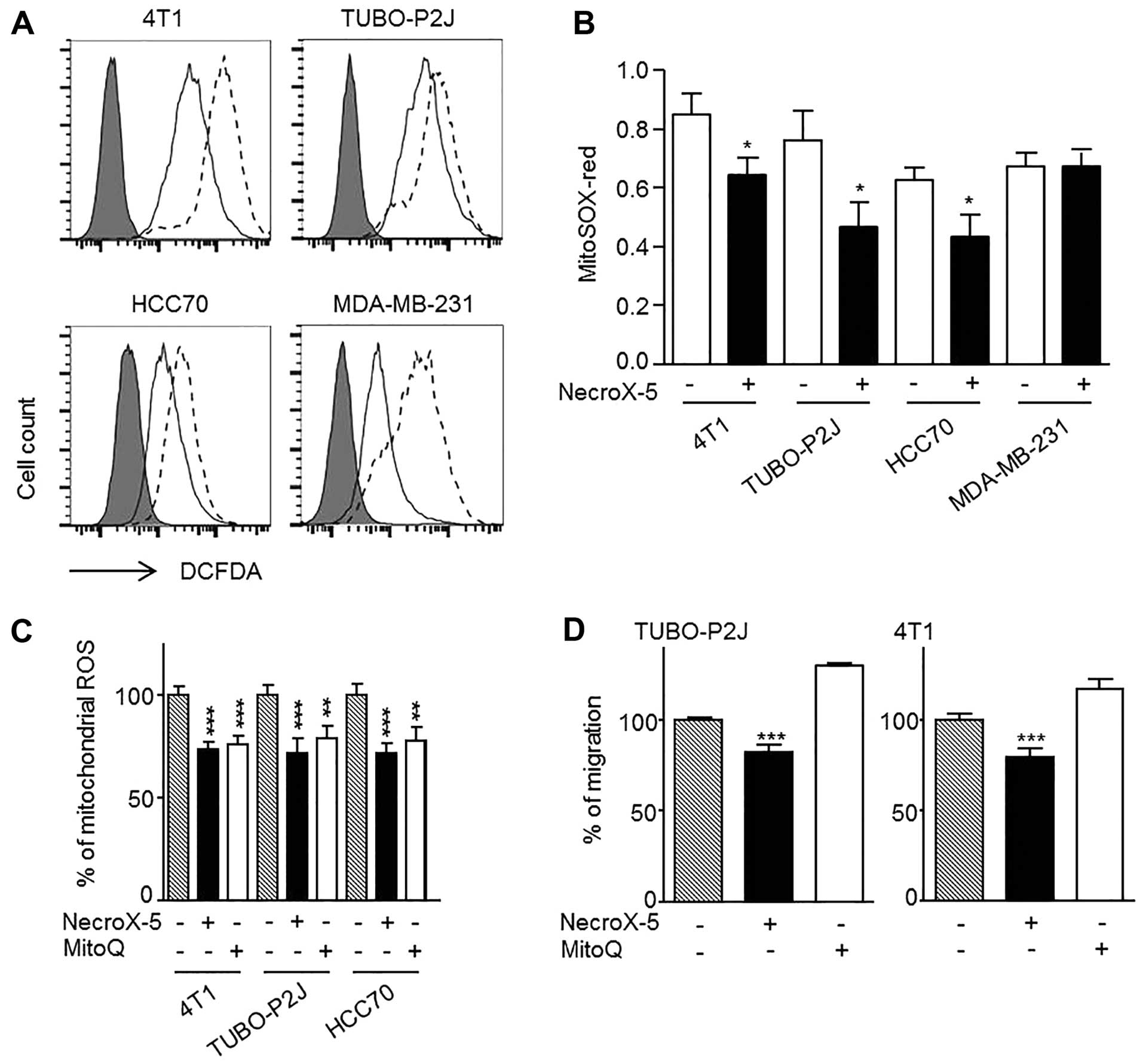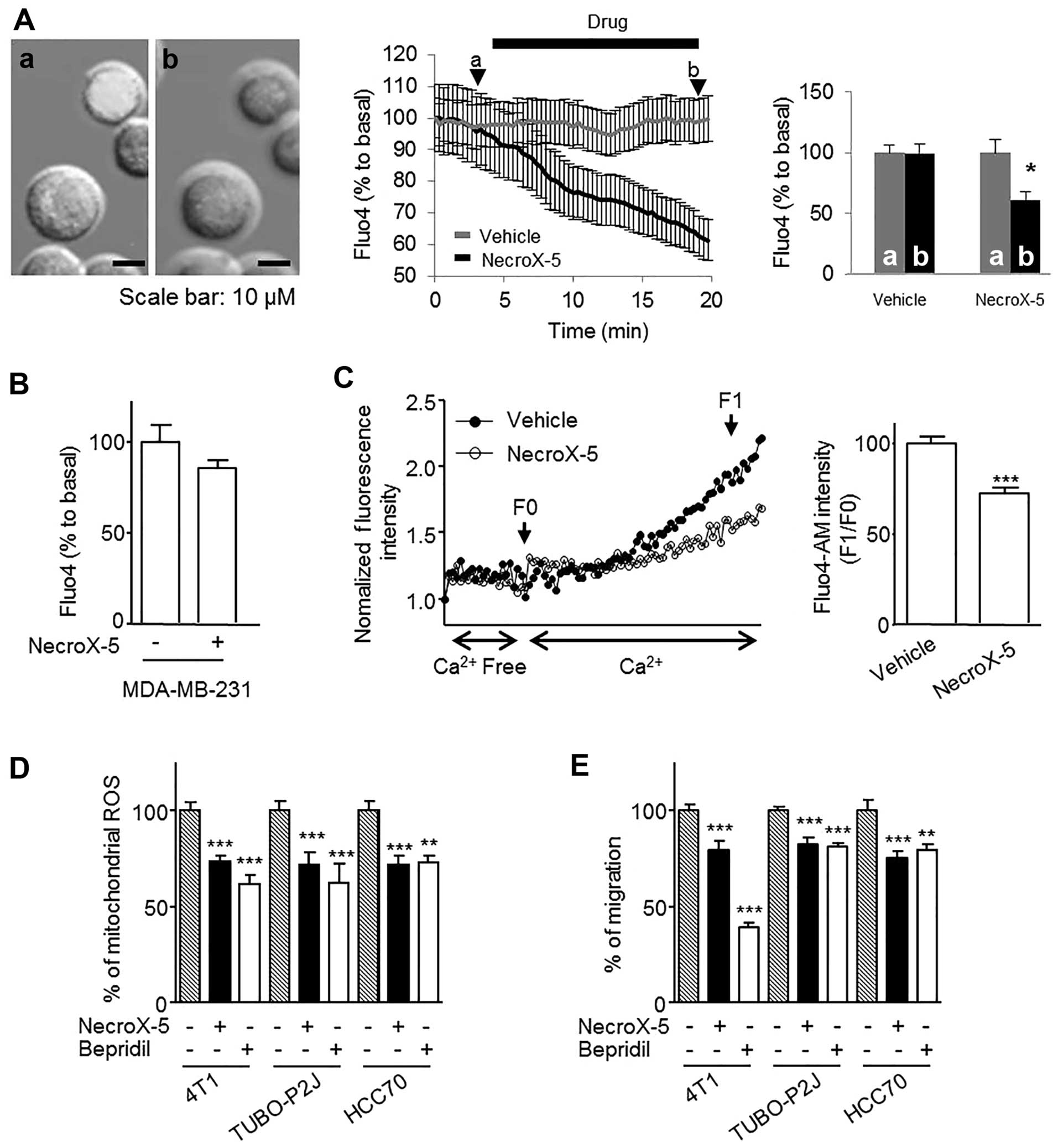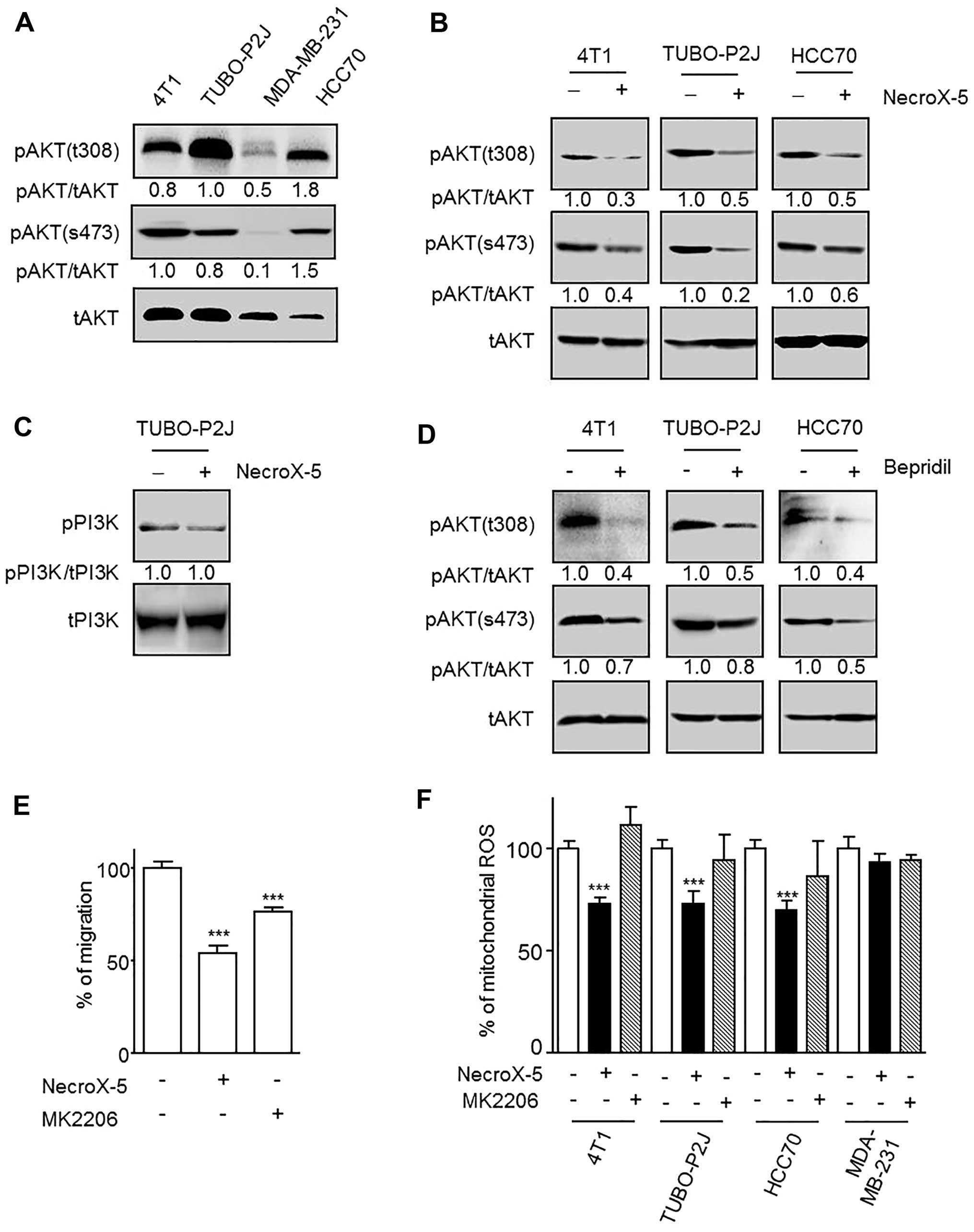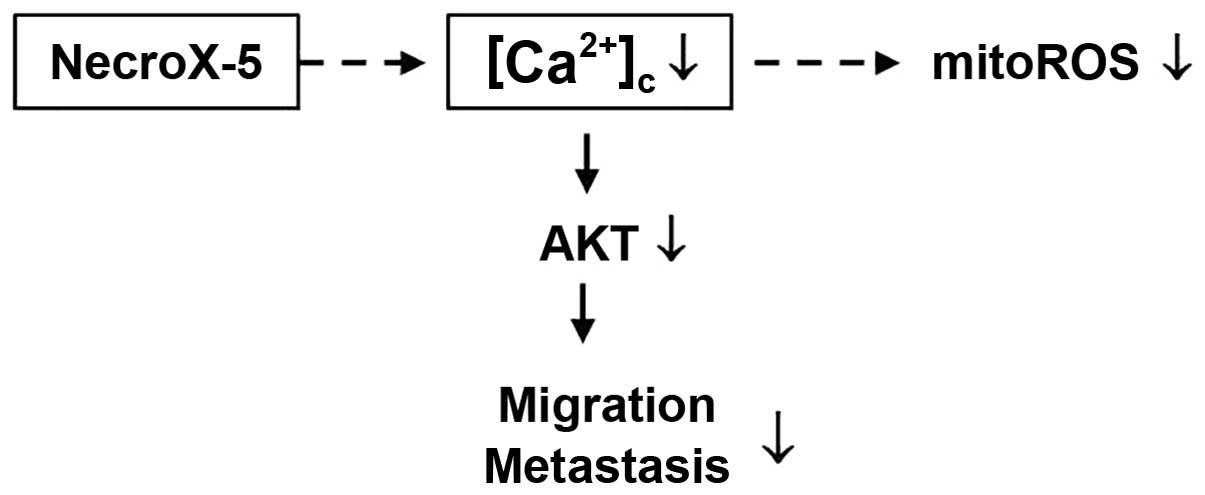NecroX-5 prevents breast cancer metastasis by AKT inhibition via reducing intracellular calcium levels
- Authors:
- Published online on: December 5, 2016 https://doi.org/10.3892/ijo.2016.3789
- Pages: 185-192
Abstract
Introduction
Breast cancer is the most common malignancy and second leading cause of cancer death in women, accounting for 29% of all female cancers and 15% of all cancer deaths (1). The main cause of death in breast cancer patients is metastasis (1). Therefore, preventing or controlling the molecular events that lead to tumour metastasis is a major goal in breast cancer research and treatment design. Metastases occur when cancer cells from a primary tumour site spread to distant organs and form new tumours. Metastasis is a multistep process that includes migration and invasion, intravasation, arrest and extravasation, and metastatic colonization (2). Cancer cell migration is induced by various signalling molecules, including transforming growth factor-β (TGF-β), integrin, receptor tyrosine kinase, and reactive oxygen species (ROS).
The role of ROS in triggering signalling pathways for cell migration and invasion has been well-established (3,4). ROS, particularly superoxide and peroxide, are constantly generated inside cells by specific enzyme complexes, such as NADPH oxidase (NOX) and nitric oxide synthases (NOS); they are also generated as by-products of oxidation-reduction reactivations, including those underlying mitochondrial respiration (5). In transformed epithelial cells, constitutively activated mitogenic pathways increase intracellular ROS directly or by activating metabolic pathways (6). Additionally, endogenous ROS can be generated by a variety of sources. Mitochondria are major sites of ROS generation in mammalian cells, and mitochondrial ROS (mitoROS) functions as a signalling molecule that stimulates cell proliferation and motility (7). Targeting mitochondria to reduce ROS is an emerging strategy for treating cancer. Goh et al used transgenic mice expressing the mitochondrial catalase and mouse mammary tumour virus-polyoma middle T oncoprotein (MMTV-PyMT) and demonstrated that targeting mitoROS could inhibit tumour progression and prevent metastasis (8).
NecroX-5 is a derivative of the NecroX series of compounds, all of which are mitoROS scavengers (9–11). The chemical composition of NecroX-5 is C25H31N3O3S•2CH4O3S with a molecular weight of 645.83 g/mol (Fig. 1). The therapeutic aim of NecroX is to protect cells from necrotic damage caused by CCl4-induced hepatotoxicity, gentamicin-induced ototoxicity, and ischaemic injury in the liver and heart (9–12). However, the anti-tumourigenic effects of NecroX-5 have not been explored to date. In this study, we evaluated whether NecroX-5 can inhibit the metastasis of breast cancer cells and sought to elucidate the molecular mechanisms of this inhibition.
Materials and methods
Reagents and cell lines
DNase and collagenase (Sigma-Aldrich, St. Louis, MO, USA) were dissolved in Dulbecco's modified Eagle's medium (DMEM). NecroX-5 (LG Life Sciences, Ltd., Seoul, Korea), Mitoquinone (MitoQ; BioTrend, Switzerland), 2′,7′-dichlorodihydrofluorescein diacetate (H2DCFDA), MitoSOX-red, Fluo4-AM (Thermo Fisher Scientific, Waltham, MA, USA), MK-2206 (Biovision, Palo Alto, CA, USA), and bepridil (bepridil hydrochloride; Sigma-Aldrich) were dissolved in dimethyl sulphoxide (DMSO) for each condition and dose. Mouse breast cancer 4T1 and human breast cancer HCC70, MDA-MB-231 and MDA-MB-453 cells were purchased from the American Type Culture Collection (ATCC, Manassas, VA, USA). The TUBO-P2J cell line was established from a metastatic lung nodule that had spontaneously developed during a mechanistic study involving an anti-neu antibody in TUBO-bearing mice (13). Cells were grown in DMEM of RPMI with 10% fetal bovine serum and 1% penicillin, and cultured at 37°C with 5% CO2.
Animal study and lung colony assay
Six-week-old female BALB/c mice were obtained from Orient Bio (Taejun, Korea). Tumours were established by the subcutaneous injection of 2×105 TUBO-P2J cells into the backs of the mice. When the tumour volume reached 100–150 mm3 in the treatment group, NecroX-5 was dissolved in phosphate-buffered saline (PBS) and administered via intraperitoneal injection (2.5 mg/kg/day). The same volume of PBS was injected into the control group. Tumour volumes were measured along three orthogonal axes (x, y and z) and calculated as tumour volume = (xyz)/2. All animal procedures were performed in accordance with the animal experimental guidelines set by the Institutional Animal Care and Use Committee of the INJE University College of Medicine (protocol no. 2013-018). Lung metastasis was evaluated using a lung colony assay on day 23 following tumour implantation. Single cell suspensions were prepared from the lung tissue via enzyme digestion using a mixture of DNase (0.1 mg/ml) and collagenase (4 mg/ml) and seeded in 48-well culture plates in a 4-fold serial dilution. The plates were incubated in complete DMEM with 500 μg/ml of G418 (Sigma-Aldrich) and stained between days 10 and 14 with crystal violet (0.1% crystal violet acetate).
Migration assay
Breast cancer cell migration was evaluated with 24-well Transwell plates (Falcon, Bedford, MA, USA). The appropriate number of cells was added to the upper chamber and incubated for 6 or 24 h. The upper surface of the membrane was wiped with a cotton-tipped applicator to remove residual cells. Cells in the bottom compartment were fixed and stained with hematoxylin and eosin (H&E). Cells in four randomly selected fields at ×200 magnification were counted.
ROS measurements
Cytoplasmic ROS (cytoROS) was measured with H2DCFDA. Cells treated with Necrox-5 and MK-2206 for 1 h were harvested with trypsin (0.025%) and stained with 10 μM H2DCFDA for 30 min at 37°C. Fluorescence intensity was measured using a FACSCanto II flow cytometer (BD Biosciences, Franklin Lakes, NJ, USA). MitoROS was measured with MitoSOX-red. Cells were treated with NecroX-5, MK-2206 and bepridil for 1 h in 96-well black microplates (Corning, Inc., Corning, NY, USA) and loaded with 5 μM MitoSOX-red. MitoROS levels were detected with a fluorescence reader (Molecular Devices, Sunnyvale, CA, USA) at 510/580 nm.
Western blot assay
Whole-cell lysates were prepared in radio-immunoprecipitation assay (RIPA) buffer (Thermo Fisher Scientific) on ice with an added phosphatase inhibitor cocktail (PhosSTOP, cat no. 04906845001; Roche, Basel, Switzerland). The protein concentrations for each sample were determined using the bicinchoninic acid (BCA) protein assay kit (Thermo Fisher Scientific) according to the manufacturer's directions. Equal amounts of protein (40 μg) were resolved by electrophoresis on 10% sodium dodecyl sulphate (SDS) polyacrylamide gels and transferred to nitrocellulose membranes. The membranes were blocked with 5% non-fat dry milk in TBS and incubated at room temperature for 2 h with primary antibodies pAKT t308 (monoclonal, rabbit, dilution used 1:1,000, cat no. 2965), pAKT s473 (monoclonal, rabbit, dilution used 1:1,000, cat no. 4058), AKT (polyclonal, rabbit, dilution used 1:2,000, cat no. 9272), PI3K p85 (polyclonal, rabbit, dilution used 1:1,000, cat no. 4292), and pPI3K p110α (polyclonal, rabbit, dilution used 1:1,000, cat no. 4255) (Cell Signaling Technology). One hour with secondary antibodies were diluted 1:2,000 and incubated for 1 h (IgG HRP-linked, anti-rabbit and anti-mouse antibodies, cat no. 7074 and 7076, respectively; Cell Signaling Technology). The results were visualized using enhanced chemiluminescent (ECL) detection reagents (Millipore, Darmstadt, Germany).
Ca2+ measurements
The effects of NecroX-5 on intracellular calcium levels were analysed with Fluo-4 AM and a confocal microscope (LSM 700; Carl Zeiss, Oberkochen, Germany). Briefly, harvested cells were washed twice with PBS and incubated at 37°C with 5 μM Fluo-4 AM (excitation/emission, 494/506 nm). After washing twice with PBS, the stained cells were placed in a perfusion chamber at room temperature. Fluorescence intensity was measured every 30 sec using a confocal microscope with ZEN 2009 software. Regions of interest in the cells were selected to monitor changes in fluorescence intensity over time, and background was identified as an area without cells. Fluorescence intensity in cells treated for 10 min with normal tyrode solution [143.0 mM NaCl, 5.4 mM KCl, 1.8 mM CaCl2, 0.5 mM MgCl2, 5.5 mM glucose, and 5.0 mM N-2-hydroxyethylpiperazine-N′-2-ethanesulphonic acid [HEPES, pH 7.4)] was used as the baseline value (F0). Fluorescence intensity during NecroX-5 perfusion (10 μM) was recorded every 30 sec for 20 min, and peak values (F1) were analysed relative to the baseline value (F1/F0) after subtracting the autofluorescence in the absence of any fluorescent dye. The temperature was set to 23±1°C while recording. To measure calcium influx, intracellular free Ca2+ was depleted with ethylene glycol tetraacetic acid (EGTA, 3 mM) and thapsigargin (TG, 2 μM). Ca2+ influx was induced by the subsequent addition of 2 mM Ca2+ with or without NecroX-5 and measured with a fluorescence reader (Molecular Devices) at 485/520 nm.
Results
NecroX-5 reduces breast cancer cell metastasis by inhibiting cell migration
To test the anticancer effects of NecroX-5, TUBO-P2J tumour-bearing mice were treated three times with 500 μg of NecroX-5 every other day. NecroX-5 treatment did not inhibit tumour growth (Fig. 2A), however, it was able to significantly extend the mean survival from 40.5 to 55 days (p<0.05) (Fig. 2B). The number of cells that metastasized to the lung was also significantly reduced by 60% (Fig. 2C). These data suggested that NecroX-5 inhibited the metastasis of TUBO-P2J cells, without inhibiting the tumour growth. To determine whether the anti-metastatic effect of NecroX-5 was related to an inhibition of cell migration, we performed a Transwell migration assay. NecroX-5 significantly decreased the migration of the mouse breast cancer cell lines 4T1 and TUBO-P2J, in a dose-dependent manner (Fig. 3A and B). However, NecroX-5 had a different effect on the human breast cancer cells. While it reduced the number of migrated cells in HCC70, it had no effect in MDA-MB-231 (Fig. 3C).
NecroX-5 indirectly reduces mitoROS levels
To determine whether the observed decrease in cancer cell migration was related to the ROS scavenging activity of NecroX-5, the levels of cytoROS and mitoROS were measured with H2DCFDA and MitoSOX-red staining, respectively. The intensity of H2DCFDA decreased following NecroX-5 treatment in all the breast cancer cells tested (Fig. 4A). Interestingly, MDA-MB-231 cells exhibited the most dramatic decrease in H2DCFDA intensity. Similarly, MitoSOX-red intensities significantly decreased in 4T1, TUBO-P2J and HCC70 cells, but appeared unchanged in the MDA-MB-231 cells, which were not susceptible to NecroX-5 (Fig. 4B). Next, we utilized MitoQ to test whether the observed decrease in migration was modulated by the reduction in mitoROS levels. MitoQ had a similar effect on mitoROS levels as NecroX-5 (Fig. 4C), however, it did not inhibit cell migration (Fig. 4D). These data suggested that the reduction in mitoROS caused by NecroX-5 was not a direct cause of cell migration inhibition.
NecroX-5 reduces intracellular calcium concentrations by limiting calcium influx, which decreases mitoROS levels and inhibited cell migration
NecroX-5 can reduce mitochondrial calcium (Ca2+) concentrations, which is important for mitoROS regulation and cell migration (10,14,15). Accordingly, we evaluated changes in intracellular free calcium concentrations using Fluo-4 AM staining. In the HCC70 cells, NecroX-5 decreased intracellular free Ca2+ by 50% within 20 min (Fig. 5A) but had no effect in MDA-MB-231 (Fig. 5B). To determine whether the decrease in Intracellular Ca2+ was mediated by a decrease in Ca2+ influx, 4T1 cells were treated with TG and ethylene glycol tetraacetic acid to chelate Ca2+ and its subsequent influx was followed. NecroX-5-treated cells significantly decreased the Ca2+ influx (Fig. 5C). To test if the decrease in Intracellular Ca2+ was related to the biological effect of NecroX-5, we utilized the calcium influx blocker bepridil. Bepridil treatment significantly reduced mitoROS levels (Fig. 5D) and decreased the migratory ability of 4T1, TUBO-P2J and HCC70 cells (Fig. 5E). These data suggest that the effect of NecroX-5 on cancer cell migration and mitoROS levels is mediated by a reduction in Intracellular Ca2+ concentrations.
NecroX-5 effect on cell migration is mediated by AKT inhibition
One of the differences between the NecroX-5 responsive and non-responsive cell lines was the basal activity of AKT. 4T1, TUBO-P2J and HCC70 responded to NecroX-5 and demonstrated full AKT activation (phosphorylation at Thr308 and Ser473), whereas MDA-MB-231 did not respond to NecroX-5 or display AKT activation (Fig. 6A). Additionally, treatment with 10 μM NecroX-5 significantly reduced the AKT activation levels in all of the responsive cell lines (Fig. 6B). Unlike the downregulation of AKT, pPI3K levels were not changed by NecroX-5 (Fig. 6C). Furthermore, we found this PI3K-independent AKT inhibition was also inducible by bepridil (Fig. 6D). We used an AKT specific inhibitor (MK-2206) to test if AKT inhibition mediated the reduction in cell migration and mitoROS levels. The migratory ability of 4T1 cells was found to be significantly reduced upon treatment with 2.5 μM MK-2206 (Fig. 6E). In contrast, MK-2206 did not reduce mitoROS levels in any of the tested cells (Fig. 6F).
Discussion
This study evaluated the inhibitory effects of NecroX-5 on breast cancer cell metastasis in order to elucidate the NecroX-5 mechanism of action. We demonstrated the inhibitory effects of NecroX-5 on lung metastasis and its ability to extend mouse survival significantly. Additionally, Transwell migration assays revealed that NecroX-5 inhibits cell migration. Interestingly, NecroX-5 did not inhibit migration in any of the breast cancer cell lines tested, leading us to conclude that there were differences in how the cell lines responded to the inhibitory mechanisms of NecroX-5.
Cell migration and invasion are the first steps of metastasis. A growing body of evidence suggests that ROS plays important roles in cell migration and invasion (3). Sources of intracellular ROS include the mitochondrial electron transport chain (ETC), phagocytic and non-phagocytic NOX, xanthine oxidases, cyclooxygenases (COX), and lipoxygenases (LOX) (16). However, it is currently unclear which sources are more important for tumour metastasis. In this study, cytoROS and mitoROS were separately evaluated with H2DCFDA and MitoSOX-red, respectively. NecroX-5 medicated inhibition of cell migration correlated with the reduced levels of mitoROS, but not cytoROS. This suggested that mitoROS levels are an important target for controlling tumour metastasis. However, other studies have suggested that the inhibition of cell migration and metastasis correlated with reduced cytoROS levels (8,17–19). These differences could be due to differences in experiment settings. Others evaluated migration under specific conditions, whereas we assessed intrinsic migration without any stimulation. Alternatively, NecroX-5 may also inhibit migration by means other than the reduction of mitoROS levels that we identified in this study. Additionally, we concluded that NecroX-5 reduced mitoROS levels indirectly because they remained unchanged in MDA-MB-231 after treatment. Furthermore, experiments with MitoQ demonstrate that reduced mitoROS levels by NecroX-5 may not inhibit cell migration.
MitoROS levels are directly regulated by multiple inputs, including Sirt3, Forkhead box O transcription factors (FOXOs), immunoreceptors, PI3K-AKT, hypoxia, cytokine stimulation, calcium influx, mitophagy and uncoupling proteins (UCPs) (14). Among these inputs, we evaluated changes in the intracellular Ca2+ concentrations because it modulates both ROS generation and clearance (20,21). Moreover, calcium is a critical regulator of cell migration (15,22–27). NecroX-5 has been shown to reduce mitochondrial calcium concentrations (10); our results demonstrate that NecroX-5 significantly reduced intracellular Ca2+ in NecroX-5-responsive cells (HCC70 and 4T1), but not in unresponsive cells (MDA-MB-231). intracellular Ca2+ levels are determined by a balance between 'on' reactions that introduce Ca2+ into the cytoplasm and 'off' reactions that signal its removal through a coordinated effort of buffers, pumps, and exchangers (28). The 'on' reactions involves calcium influx from the extracellular space and calcium release from intracellular storage in various organelles, including the endoplasmic/sarcoplasmic reticulum (ER/SR), lysosomes, and mitochondria (15). Although we could not rule out other mechanisms that participate in Ca2+ homeostasis, we were able to demonstrate that NecroX-5 reduced Ca2+ influx from the extracellular space. Blocking experiments with bepridil demonstrated that NecroX-5′s mechanism of action is to reduce the Ca2+ influx, thereby mediating the reduction of mitoROS levels and the inhibition of cell migration.
We also evaluated the PI3K/AKT pathway because it has been shown to promote cell survival and increase proliferation and motility (29,30). Also NecroX-5 inhibits both cell proliferation and migration in HCC70 cells, and NecroX-5 responsive cell lines exhibited full activation of AKT at baseline (Thr308 and Ser473), while unresponsive cells did not. Western blot analysis revealed that NecroX-5 inhibited AKT in a PI3K-independent and intracellular calcium-dependent manner. In a previous study, AKT was shown to be regulated by calcium/calmodulin in a PI3K-independent manner (31,32). Thus, it is possible that AKT downregulation by NecroX-5 may be mediated by calmodulin inactivation in response to intracellular calcium reduction.
In conclusion, this study introduced NecroX-5 as a novel anticancer drug that inhibits tumour cell metastasis through the Ca2+-dependent modulation of AKT signalling (Fig. 7). Additionally, the downregulation of AKT by blocking calcium influx may be the mechanism by which NecroX-5 inhibits migration. Finally, we found that mitoROS reduction was not related to AKT downregulation (Fig. 7). Future studies should attempt to elucidate the mechanisms by which intracellular calcium concentrations decrease, identify target channels, and evaluate the effects of calcium release in the context of NecroX-5 treatment.
Acknowledgments
This study was supported by the National Research Foundation of Korea (NRF) and funding granted by the Ministry of Education of Korea (2010-0020224) and by the Ministry of Science, and Future Planning (R13-2007-023-00000-0).
References
|
Siegel R, Naishadham D and Jemal A: Cancer statistics, 2013. CA Cancer J Clin. 63:11–30. 2013. View Article : Google Scholar : PubMed/NCBI | |
|
Steeg PS: Tumor metastasis: Mechanistic insights and clinical challenges. Nat Med. 12:895–904. 2006. View Article : Google Scholar : PubMed/NCBI | |
|
Hurd TR, DeGennaro M and Lehmann R: Redox regulation of cell migration and adhesion. Trends Cell Biol. 22:107–115. 2012. View Article : Google Scholar : PubMed/NCBI | |
|
Tochhawng L, Deng S, Pervaiz S and Yap CT: Redox regulation of cancer cell migration and invasion. Mitochondrion. 13:246–253. 2013. View Article : Google Scholar | |
|
Pani G, Galeotti T and Chiarugi P: Metastasis: Cancer cell's escape from oxidative stress. Cancer Metastasis Rev. 29:351–378. 2010. View Article : Google Scholar : PubMed/NCBI | |
|
Halliwell B: Oxidative stress and cancer: Have we moved forward? Biochem J. 401:1–11. 2007. View Article : Google Scholar | |
|
Storz P: Reactive oxygen species in tumor progression. Front Biosci. 10:1881–1896. 2005. View Article : Google Scholar : PubMed/NCBI | |
|
Goh J, Enns L, Fatemie S, Hopkins H, Morton J, Pettan-Brewer C and Ladiges W: Mitochondrial targeted catalase suppresses invasive breast cancer in mice. BMC Cancer. 11:1912011. View Article : Google Scholar : PubMed/NCBI | |
|
Kim HJ, Koo SY, Ahn BH, Park O, Park DH, Seo DO, Won JH, Yim HJ, Kwak HS, Park HS, et al: NecroX as a novel class of mitochondrial reactive oxygen species and ONOO− scavenger. Arch Pharm Res. 33:1813–1823. 2010. View Article : Google Scholar : PubMed/NCBI | |
|
Thu VT, Kim HK, Long T, Lee SR, Hanh TM, Ko TH, Heo HJ, Kim N, Kim SH, Ko KS, et al: NecroX-5 prevents hypoxia/reoxygenation injury by inhibiting the mitochondrial calcium uniporter. Cardiovasc Res. 94:342–350. 2012. View Article : Google Scholar : PubMed/NCBI | |
|
Park MK, Lee BD, Chae SW, Chi J, Kwon SK and Song JJ: Protective effect of NecroX, a novel necroptosis inhibitor, on gentamicin-induced ototoxicity. Int J Pediatr Otorhinolaryngol. 76:1265–1269. 2012. View Article : Google Scholar : PubMed/NCBI | |
|
Choi JM, Park KM, Kim SH, Hwang DW, Chon SH, Lee JH, Lee SY and Lee YJ: Effect of necrosis modulator necrox-7 on hepatic ischemia-reperfusion injury in beagle dogs. Transplant Proc. 42:3414–3421. 2010. View Article : Google Scholar : PubMed/NCBI | |
|
Song H, Kim TO, Ma SY, Park JH, Choi JH, Kim JH, Kang MS, Bae SK, Kim KH, Kim TH, et al: Intratumoral heterogeneity impacts the response to anti-neu antibody therapy. BMC Cancer. 14:6472014. View Article : Google Scholar : PubMed/NCBI | |
|
Sena LA and Chandel NS: Physiological roles of mitochondrial reactive oxygen species. Mol Cell. 48:158–167. 2012. View Article : Google Scholar : PubMed/NCBI | |
|
Prevarskaya N, Skryma R and Shuba Y: Calcium in tumour metastasis: New roles for known actors. Nat Rev Cancer. 11:609–618. 2011. View Article : Google Scholar : PubMed/NCBI | |
|
Gloire G, Legrand-Poels S and Piette J: NF-kappaB activation by reactive oxygen species: Fifteen years later. Biochem Pharmacol. 72:1493–1505. 2006. View Article : Google Scholar : PubMed/NCBI | |
|
Alexandrova AY, Kopnin PB, Vasiliev JM and Kopnin BP: ROS up-regulation mediates Ras-induced changes of cell morphology and motility. Exp Cell Res. 312:2066–2073. 2006. View Article : Google Scholar : PubMed/NCBI | |
|
Ishikawa K, Takenaga K, Akimoto M, Koshikawa N, Yamaguchi A, Imanishi H, Nakada K, Honma Y and Hayashi J: ROS-generating mitochondrial DNA mutations can regulate tumor cell metastasis. Science. 320:661–664. 2008. View Article : Google Scholar : PubMed/NCBI | |
|
Nishikawa M: Reactive oxygen species in tumor metastasis. Cancer Lett. 266:53–59. 2008. View Article : Google Scholar : PubMed/NCBI | |
|
Yan Y, Wei CL, Zhang WR, Cheng HP and Liu J: Cross-talk between calcium and reactive oxygen species signaling. Acta Pharmacol Sin. 27:821–826. 2006. View Article : Google Scholar : PubMed/NCBI | |
|
Zhang DX and Gutterman DD: Mitochondrial reactive oxygen species-mediated signaling in endothelial cells. Am J Physiol Heart Circ Physiol. 292:H2023–H2031. 2007. View Article : Google Scholar : PubMed/NCBI | |
|
Pettit EJ and Fay FS: Cytosolic free calcium and the cytoskeleton in the control of leukocyte chemotaxis. Physiol Rev. 78:949–967. 1998.PubMed/NCBI | |
|
Roderick HL and Cook SJ: Ca2+ signalling checkpoints in cancer: Remodelling Ca2+ for cancer cell proliferation and survival. Nat Rev Cancer. 8:361–375. 2008. View Article : Google Scholar : PubMed/NCBI | |
|
Clark K, Langeslag M, van Leeuwen B, Ran L, Ryazanov AG, Figdor CG, Moolenaar WH, Jalink K and van Leeuwen FN: TRPM7, a novel regulator of actomyosin contractility and cell adhesion. EMBO J. 25:290–301. 2006. View Article : Google Scholar : PubMed/NCBI | |
|
Waning J, Vriens J, Owsianik G, Stuwe L, Mally S, Fabian A, Frippiat C, Nilius B and Schwab A: A novel function of capsaicin-sensitive TRPV1 channels: Involvement in cell migration. Cell Calcium. 42:17–25. 2007. View Article : Google Scholar | |
|
Hewavitharana T, Deng X, Soboloff J and Gill DL: role of STIM and Orai proteins in the store-operated calcium signaling pathway. Cell Calcium. 42:173–182. 2007. View Article : Google Scholar : PubMed/NCBI | |
|
Yang S, Zhang JJ and Huang XY: Orail and STIM1 are critical for breast tumor cell migration and metastasis. Cancer Cell. 15:124–134. 2009. View Article : Google Scholar : PubMed/NCBI | |
|
Berridge MJ, Bootman MD and Roderick HL: Calcium signalling: Dynamics, homeostasis and remodelling. Nat Rev Mol Cell Biol. 4:517–529. 2003. View Article : Google Scholar : PubMed/NCBI | |
|
Cantley LC: The phosphoinositide 3-kinase pathway. Science. 296:1655–1657. 2002. View Article : Google Scholar : PubMed/NCBI | |
|
Sullivan LB and Chandel NS: Mitochondrial reactive oxygen species and cancer. Cancer Metab. 2:172014. View Article : Google Scholar | |
|
Coticchia CM, Revankar CM, Deb TB, Dickson RB and Johnson MD: Calmodulin modulates Akt activity in human breast cancer cell lines. Breast Cancer Res Treat. 115:545–560. 2009. View Article : Google Scholar | |
|
Deb TB, Coticchia CM and Dickson RB: Calmodulin-mediated activation of Akt regulates survival of c-Myc-overexpressing mouse mammary carcinoma cells. J Biol Chem. 279:38903–38911. 2004. View Article : Google Scholar : PubMed/NCBI |



